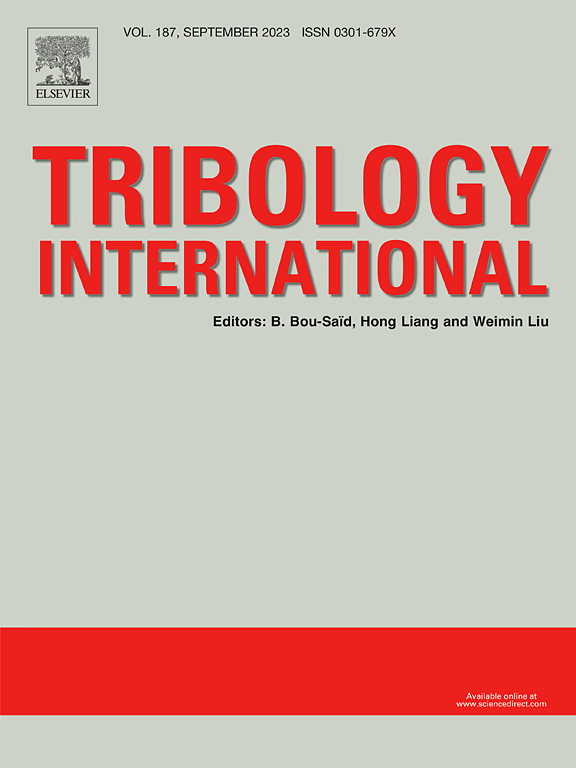Dual surface-modification by oleic acid and epoxy-based silane coupling agent providing cerium oxide nanoparticles as additive in pentaerythritol oleate with improved high-temperature adsorption performance and tribological properties
IF 6.1
1区 工程技术
Q1 ENGINEERING, MECHANICAL
引用次数: 0
Abstract
An epoxy-based silane coupling agent (KH560) was grafted onto the surface of oleic acid-modified cerium oxide (CeO-OA) nanoparticles in order to improve the competitive adsorption ability of the anti-wear additives in ester oils and simultaneously hinder the additive desorption owing to thermal disturbance under high-temperature condition. The as-prepared oleic acid-epoxy silane co-modified cerium oxide (CeO-OA/E) nanoparticles were characterized. The effect of temperature on the adsorption behavior of trityl phosphate (TCP, a commercial high-temperature antifriction agent), CeO-OA and CeO-OA/E in PETO was studied using a dissipative quartz microbalance. Their tribological properties as the additives in pentaerythritol oleate (PETO), a polar ester base oil, were evaluated with a four-ball machine and a ball-on-block friction and wear tester; and their tribomechanism was explored with respect to their adsorption behavior on rubbed steel surfaces at elevated temperatures. It was found that the secondary surface-capping of CeO-OA by the KH560 silane coupling agent resulted in great increases in the surface potential (from 54 mV to 396 mV) and thermal stability as well (the thermal decomposition temperature rose from 185 °C to 254 °C). Among the tesetd lubricant additives, CeO-OA/E exhibited the highest adsorption mass, because of the highest surface potential the chemisorption ascribed to the epoxy group of the silane coupling agent. Particularly, CeO-OA/E added in PETO exhibited better friction reduction and anti-wear properties at 150 °C than CeO-OA and TCP, because CeO-OA/E added in PETO formed tribofilm composed of CeO and SiO with excellent thermal stability as well as friction-reduction and antiwear effects through stable chemical adsorption and tribochemical reaction at elevated temperatures.通过油酸和环氧基硅烷偶联剂进行双重表面改性,提供纳米氧化铈颗粒作为季戊四醇油酸酯添加剂,改善高温吸附性能和摩擦学特性
将环氧基硅烷偶联剂(KH560)接枝到油酸改性氧化铈(CeO-OA)纳米粒子表面,以提高酯类油中抗磨添加剂的竞争吸附能力,同时阻止高温条件下由于热扰动造成的添加剂解吸。对制备的油酸-环氧硅烷共修饰氧化铈(CeO-OA/E)纳米粒子进行了表征。使用耗散石英微天平研究了温度对磷酸三苯酯(TCP,一种商用高温减摩剂)、CeO-OA 和 CeO-OA/E 在 PETO 中的吸附行为的影响。在极性酯基础油季戊四醇油酸酯(PETO)中添加这些添加剂后,使用四球机和球对块摩擦磨损测试仪对它们的摩擦学特性进行了评估,并根据它们在高温下摩擦钢表面的吸附行为探索了它们的摩擦机理。研究发现,KH560 硅烷偶联剂对 CeO-OA 进行二次表面封盖后,其表面电位(从 54 mV 升至 396 mV)和热稳定性(热分解温度从 185 °C 升至 254 °C)均大幅提高。在测试的润滑油添加剂中,CeO-OA/E 的吸附质量最高,这是因为硅烷偶联剂的环氧基团具有最高的表面电位。特别是添加在 PETO 中的 CeO-OA/E 在 150 ℃ 时的减摩抗磨性能比 CeO-OA 和 TCP 更好,这是因为添加在 PETO 中的 CeO-OA/E 在高温下通过稳定的化学吸附和摩擦化学反应形成了由 CeO 和 SiO 组成的三膜,具有优异的热稳定性以及减摩抗磨效果。
本文章由计算机程序翻译,如有差异,请以英文原文为准。
求助全文
约1分钟内获得全文
求助全文
来源期刊

Tribology International
工程技术-工程:机械
CiteScore
10.10
自引率
16.10%
发文量
627
审稿时长
35 days
期刊介绍:
Tribology is the science of rubbing surfaces and contributes to every facet of our everyday life, from live cell friction to engine lubrication and seismology. As such tribology is truly multidisciplinary and this extraordinary breadth of scientific interest is reflected in the scope of Tribology International.
Tribology International seeks to publish original research papers of the highest scientific quality to provide an archival resource for scientists from all backgrounds. Written contributions are invited reporting experimental and modelling studies both in established areas of tribology and emerging fields. Scientific topics include the physics or chemistry of tribo-surfaces, bio-tribology, surface engineering and materials, contact mechanics, nano-tribology, lubricants and hydrodynamic lubrication.
 求助内容:
求助内容: 应助结果提醒方式:
应助结果提醒方式:


